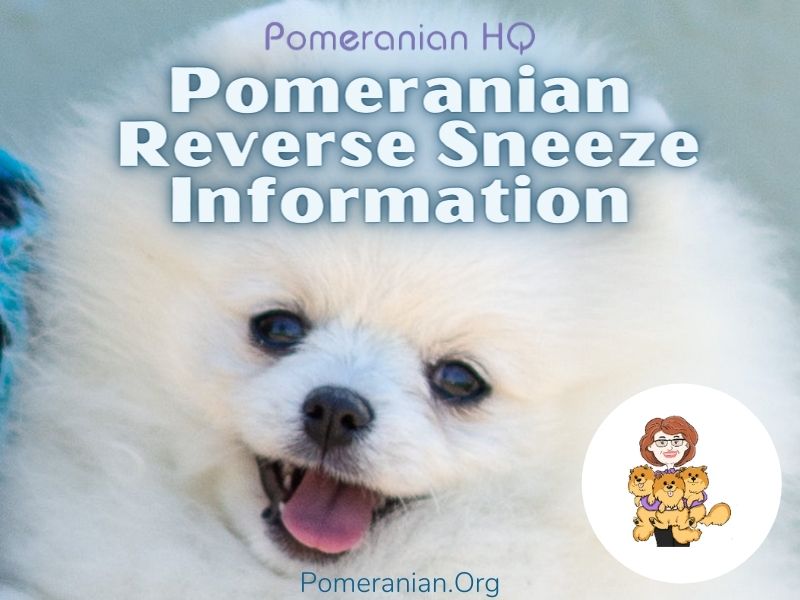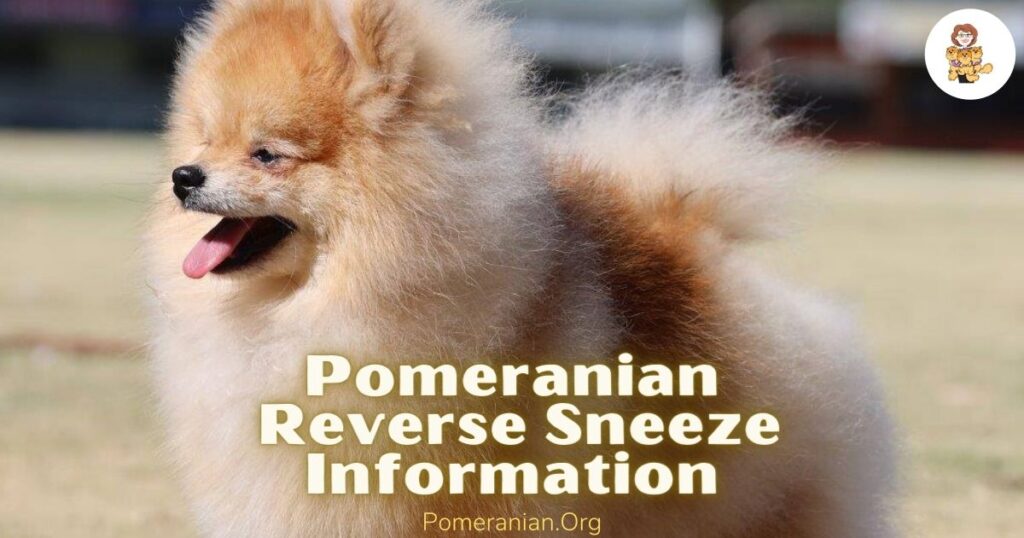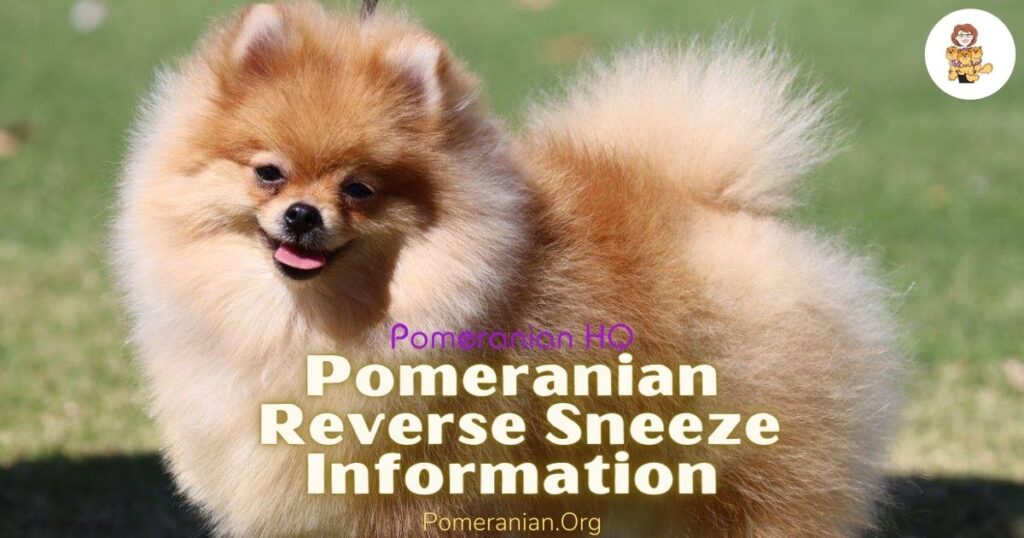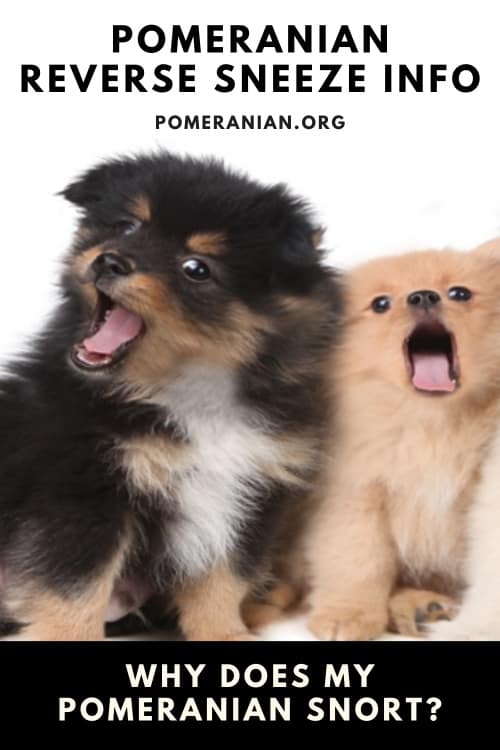Last Updated on 08/02/2022 by Dochlaggie. Post first published on February 8, 2022.
Whenever your Pomeranian greets a guest, he’s always excited and, because of this, he may have breathing trouble. This is known as reverse sneezing in Pomeranians or a Pomeranian sneeze attack.
My nickname for this problem is the “Boofles.” My quick fix for stopping this is to prevent my Pom from moving, while gently holding his nostrils so he’s forced to use his mouth to breathe. Generally speaking, you can stop any spasms by either: gently massaging his throat or closing his nostrils until he swallows.
Why Does My Pomeranian Snort?
Lots of Pomeranians have a problem called paroxysmal respiration. This is better known as Pomeranian reverse sneeze. The way it works is like this: he quickly draws air in via his nostrils; whereas, in a normal sneeze, the air is quickly pushed out via his nose. Why your Pomeranian snorts is because he’s attempting to inhale while, simultaneously, sneezing.
Reverse sneezing in a Pomeranian occurs when your dog suddenly and forcefully inhales through his nose. That makes him snort repeatedly and the sound he makes resembles a choking sound. It looks and sounds likes he’s trying to inhale a sneeze; that’s where the nickname, “Pomeranian reverse sneeze,” comes from.
He might do this if his palate and/or larynx are, somehow, irritated and muscle spasms can occur in his pharynx. While your Pom is reverse sneezing, he’s also gasping inwardly, making hacking, snorting or honking sounds. The main cause of these problems is over-excitement.
Other causes of a reverse sneezing Pomeranian include: pulling too hard on his leash; as he runs; after lapping up lots of water; or after having something to eat.
Whenever you take your dog for a walk, never use a collar because a harness is much safer. A typical Pomeranian episode of reverse sneezing only lasts for a few seconds. However, there are some that experience it for a few minutes, more than once each day.
Reasons for Pomeranian Sneeze Attacks
Nobody knows the specific cause of a Pomeranian honking cough or reverse sneezing. Any time your Pomeranian has irritations in the back part of his throat, his sinuses, or nose, he’ll start reverse sneezing. These episodes can range from extremely mild through to the more serious, but they’re nothing for you to be concerned about.
Canine nasal mites (Pneumonyssoides caninum) can also cause reverse sneezing, but in this case, nasal bleeding and other signs appear along with reverse sneezing. All dog breeds are susceptible to this parasitic infection.
These are potential causes of reverse sneezing:
- Getting too excited.
- Eating and drinking too fast.
- The scent of perfumes.
- Pulling too hard on his leash.
- Mites or viruses.
- Foreign substances in his throat.
- Post-nasal drip or nasal inflammation
- Household chemicals or cleaners.
Is My Pom in Danger During a Pomeranian Sneeze Attack?
If your Pom has such a problem, you must talk to your vet. If these attacks occur quite often, your vet will prescribe antihistamines to hopefully stop the sneezing. If it occurs immediately after his nose inoculation for the kennel cough, it’s advisable to give him antibiotics.
Most Pomeranians will experience a reverse sneezing episode and still go on to lead a healthy, happy life as the sneezing isn’t harmful and a lot of the time, there’s no need for any treatment.
However, never list Pomeranian reverse sneezing in the same category as far more serious Pomeranian breathing issues including heart disease or a collapsed trachea.

If you ever see symptoms that make no sense to you (such as: snorting, gagging, honking or wheezing), do the smart thing and seek professional help and advice from your vet. It’s better to be safe than sorry.
How Do You Diagnose a Pomeranian Reverse Sneeze?
A diagnosis comes as a result of clinical signs and medical history. Your vet first eliminates other reasons for snorting and abnormal breathing.
These may include:
- Nasal polyps or tumors.
- A trachea that’s starting to collapse.
- An upper respiratory tract infection.
- Foreign bodies within his nasal passages.
How to Treat Pomeranian Puppy Sneeze Issues
The majority of cases of reverse sneezing don’t need to be treated. If your Pomeranian has an episode of reverse sneezing, lightly stroke his neck as you calm him down. After he exhales through the nose, that’s the end of the problem.
Reverse sneezing is a respiratory problem where your Pomeranian breathes through his nose suddenly, repeatedly and quickly.

Usually, he does it while standing while he pulls back his lips and stretches his neck. After every inhalation, you’ll hear clear gagging and snorting sounds.
Reverse sneezing and sneezing both have an identical goal; to get rid of the irritation – to remove irritants felt in the upper respiratory tract. However, as son as any irritants get into the nose, your Pomeranian begins to sneeze. On the other hand, reverse sneezing occurs when the nasopharynx gets irritated. That’s the space at the rear of the nasal cavities.
It’s extremely rare for canines to face complications or risks during those attacks. Most reverse sneezing episodes are finished inside 60 seconds, although there are cases where it lasts longer than ever that.
Sometimes your vet may prescribe antihistamine, antibiotic or decongestant medications to assist in your dog’s recovery.
There are two key words to remember; when combined, they will help you stop your Pomeranian from experiencing a reverse sneezing episode or ensuring it’s over as fast as possible.
The first word is “understanding.” Put yourself in your Pom’s shoes (if you have a good imagination). You’ll experience one or more of the following reactions at the same time:
- Reverse sneezing.
- Snorting.
- Spasming.
- Honking.
- Wheezing.
- Gagging.
- Struggling to breathe properly.
- Using your nose to inhale quickly, suddenly, and repeatedly and quickly.
Now you have an inkling of the stress and discomfort your Pomeranian feels. It should help you understand the fastest way to help him. The second word is “calm.” Talk to him in a calm, soft voice as you go through each of the following steps in the order that best suits the particular situation. However, if he reacts badly to something you do, stop it immediately, and try a different option.
Stay calm. Maintain your calm voice because your Pomeranian will feed off your energy. If he has been a family member for a while, he should completely trust you, even if he feels uncomfortable and a little scared.
Gently massage your Pom’s throat. If there’s something irritating his throat, a massage can decrease the irritant’s effect and the period of reverse sneezing.
Offer food or drink. Offer your canine family member a drink of water or a treat. Food and/or drink can clear the rear of his tiny throat, stopping the reverse sneezing dead in its tracks. However, it’s vital that you don’t force him to eat or drink because he might be distracted and/or distressed and accidentally choke. Naturally that’s the last thing you want to happen.
Blow gentle air in his face. If your Pom is experiencing an episode of reverse sneezing, he can easily inhale a few times in a row. If you blow in his face, it can be enough to stop the spasms and this breathing cycle in which he’s trapped.Make sure you’re gentle or he might run off the next time you try it.
Size matters. Whatever you do to help your Pomeranian, whether it’s blowing, massaging or anything else, remember he’s not a St. Bernard, a German Shepherd or a Labrador. He’s a Pomeranian and, although he has a personality to match any of these much larger dogs, his body is much smaller, more fragile, and easier to damage or break, even if it’s only by accident.
Pinch his nostrils. Try to pinch your Pom’s nostrils shut. This forces him to swallow and that causes a disruption to the repeated inhalations. It may also soothe anything that’s irritating the throat, making him reverse sneeze in the first place. Only pinch his nose for a second or you could hurt him.

Carry your Pomeranian out to the back yard. The interior of your home can have lots of irritants such as mold and dust, which may start him reverse sneezing. So, if you carry him outside to the fresh air, as there won’t be irritants to affect him, he may stop the reverse sneezing. Bear in mind, he won’t move during an episode, but lucky that you chose a Pomeranian to begin with because he’s easy to lift up and carry outside. Remember to talk to him in a soft calm voice to avoid further stress.
Push your Pom’s tongue down. If nothing else has helped so far, and you trust he won’t bite you, gently press his tongue down. This action will cause him to swallow and that usually clears whatever is irritating his throat. When a Pom is having an episode, his mouth is usually open a little so inserting a digit won’t be difficult. However, if your dog is stressed, don’t let him have your finger or you could end up being accidentally bitten.
Allergy testing. If your Pomeranian experiences a lot of reverse sneezing, ask your vet to test him for allergies. If any are identified, work to eliminate them from your home. Other things you shouldn’t do include: burning candles or wood, smoking, using strong cleaners, colognes and perfumes, and make sure your home is vacuumed regularly. Get a HEPA filter so you can catch any airborne allergens.
Time for the Vet. If your Pomeranian is still in distress after trying all these tips, ring the vet. If another person is with you, ask them to make the call as it will be faster and you can keep comforting your Pom in a calm manner. If the other person drives, you can hold your dog while in the car.
Final Thoughts on Pomeranian Reverse Sneezing
Generally speaking, the occasional Pomeranian dog sneeze or Pomeranian puppy reverse sneeze episodes is nothing to be alarmed about. It’s only when it lasts for more than a few seconds or seems like it’s causing your Pom undue distress that you should speak to your vet.

Please note: while I do discuss health, care, and behavioral issues, you should never use this information as a replacement for advice from qualified veterinarians, diagnoses, or recommended treatment regimes. If you have any worries about the health of your Pomeranian, your first contact should be your regular vet or, if you don’t yet have one, a vet that works locally. Never ignore or avoid treatment and advice from your vet because of a piece of information you have read on any website.
N.B. This article regarding Pomeranian health issues was written in consultation with our resident veterinarian.
Dr. Muqeet Mushtaq
DVM, University of Animal and Veterinary Sciences, 2019
MSc. (Hons.) (Animal Breeding & Genetics), University of Agriculture Faisalabad, 2021
Copyright Pomeranian.org. All Rights Reserved.
References and Further Reading:
[1] Official Standard of the Pomeranian (AKC). American Kennel Club, 2011.
[2] English Kennel Club Pomeranian Breed Standard, 2017.
[3] Denise Leo, The Pomeranian Handbook.
[4] Milo G. Denlinger “The Complete Pomeranian.”
[5] Kimbering Pomeranians “1891-1991”.
[6] William Taplin’s “The Sportsman’s Cabinet.”
[7] E. Parker “The Popular Pomeranian.”
[8] Lilla Ives “Show Pomeranians.”







